Dyschronics Guided Tour
Welcome to Dyschronics. We invite you to use the following audiovisual guide to navigate the installation, sculptures, textiles, videos, film, and performance throughout the galleries of Artspace New Haven.
DYSCHRONICS February 11—April 16, 2022

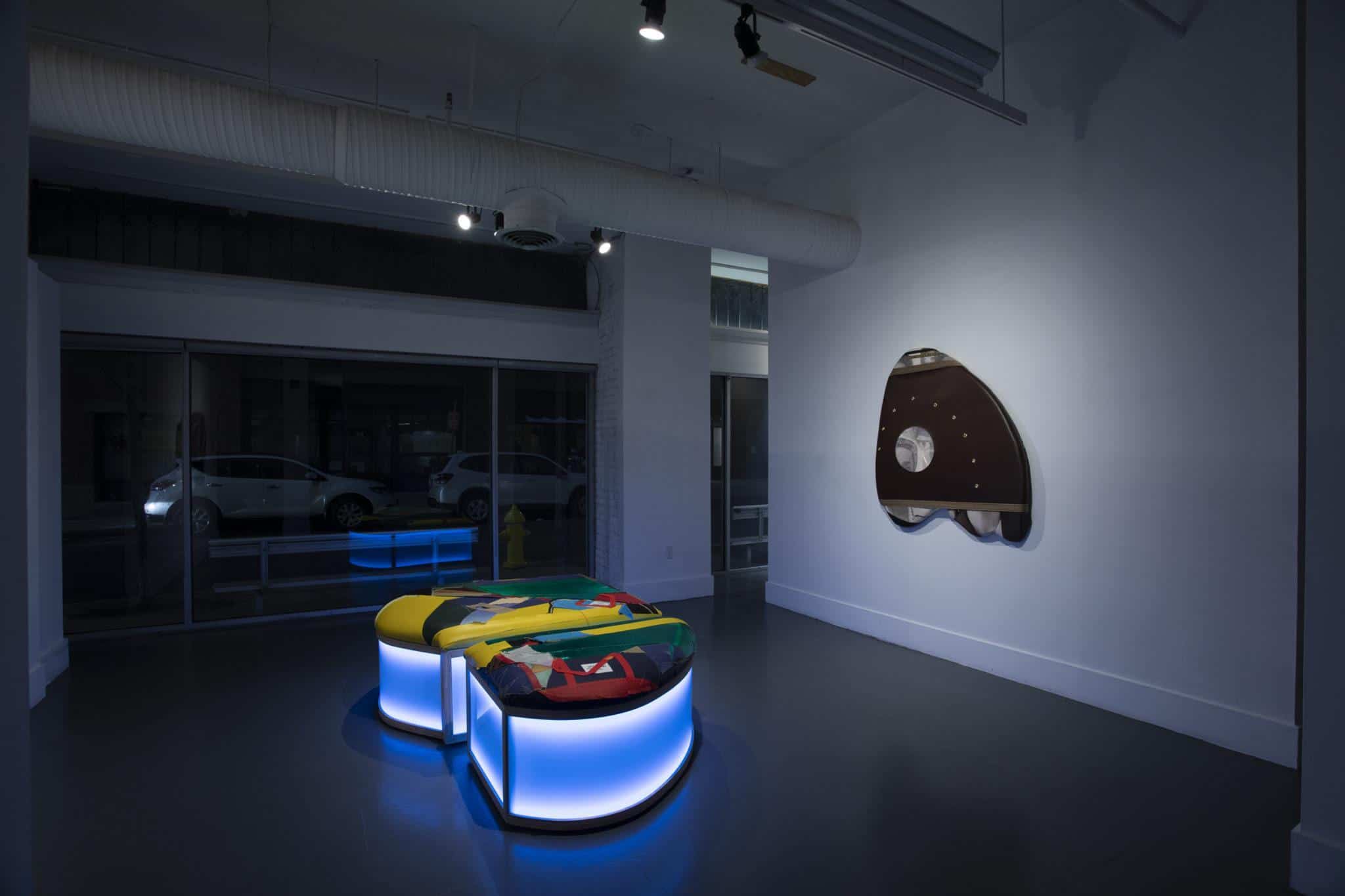
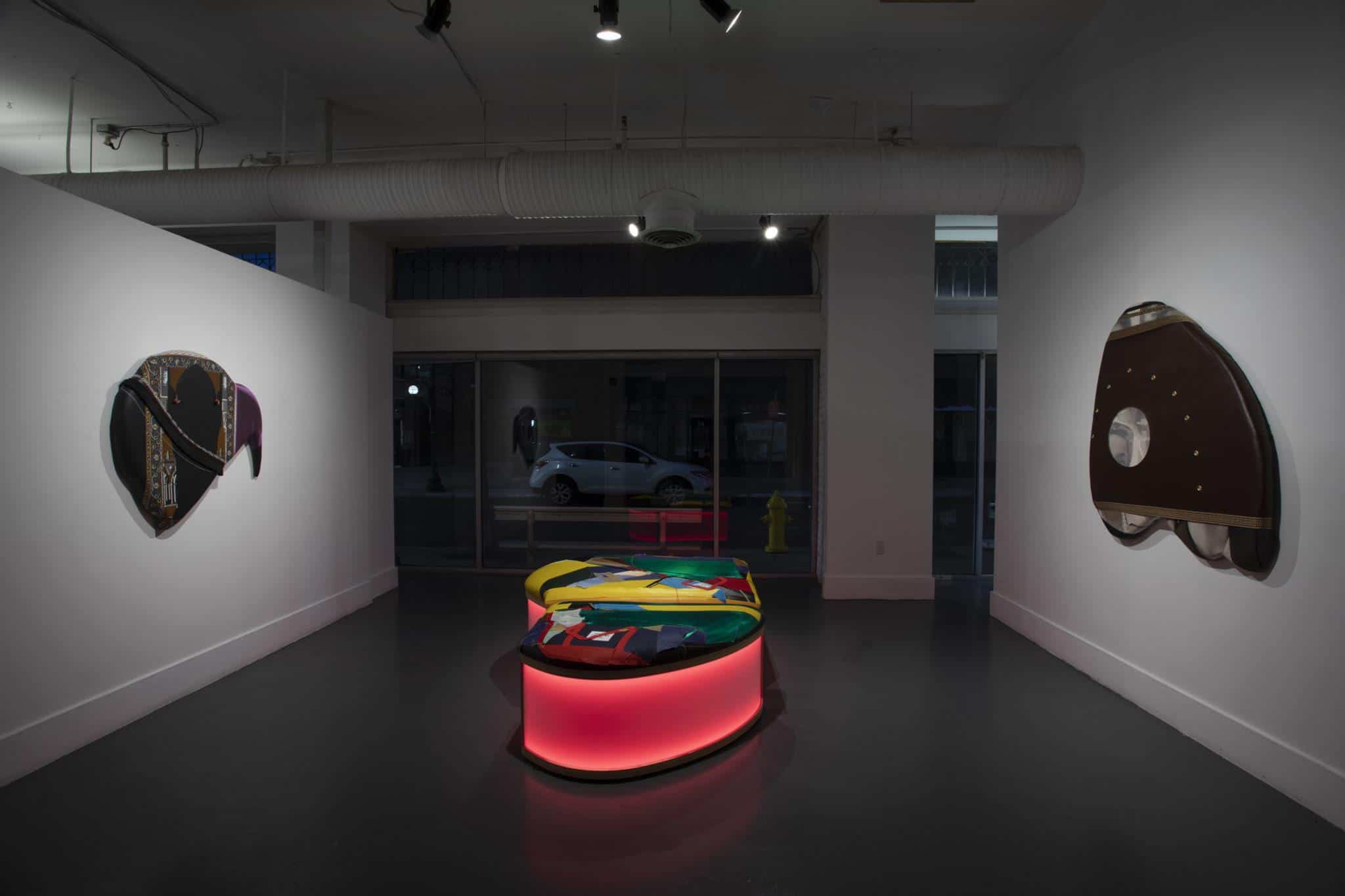

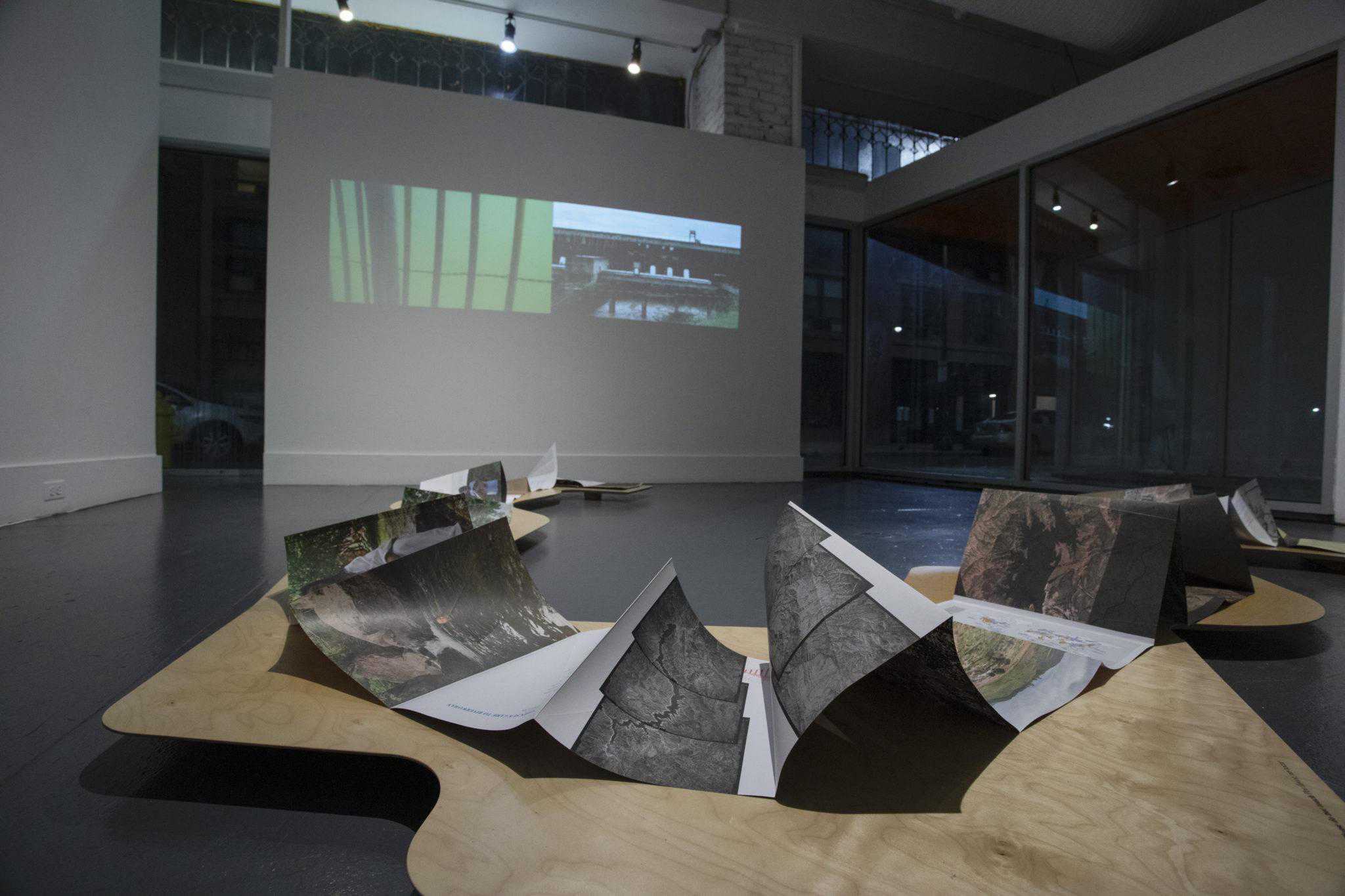

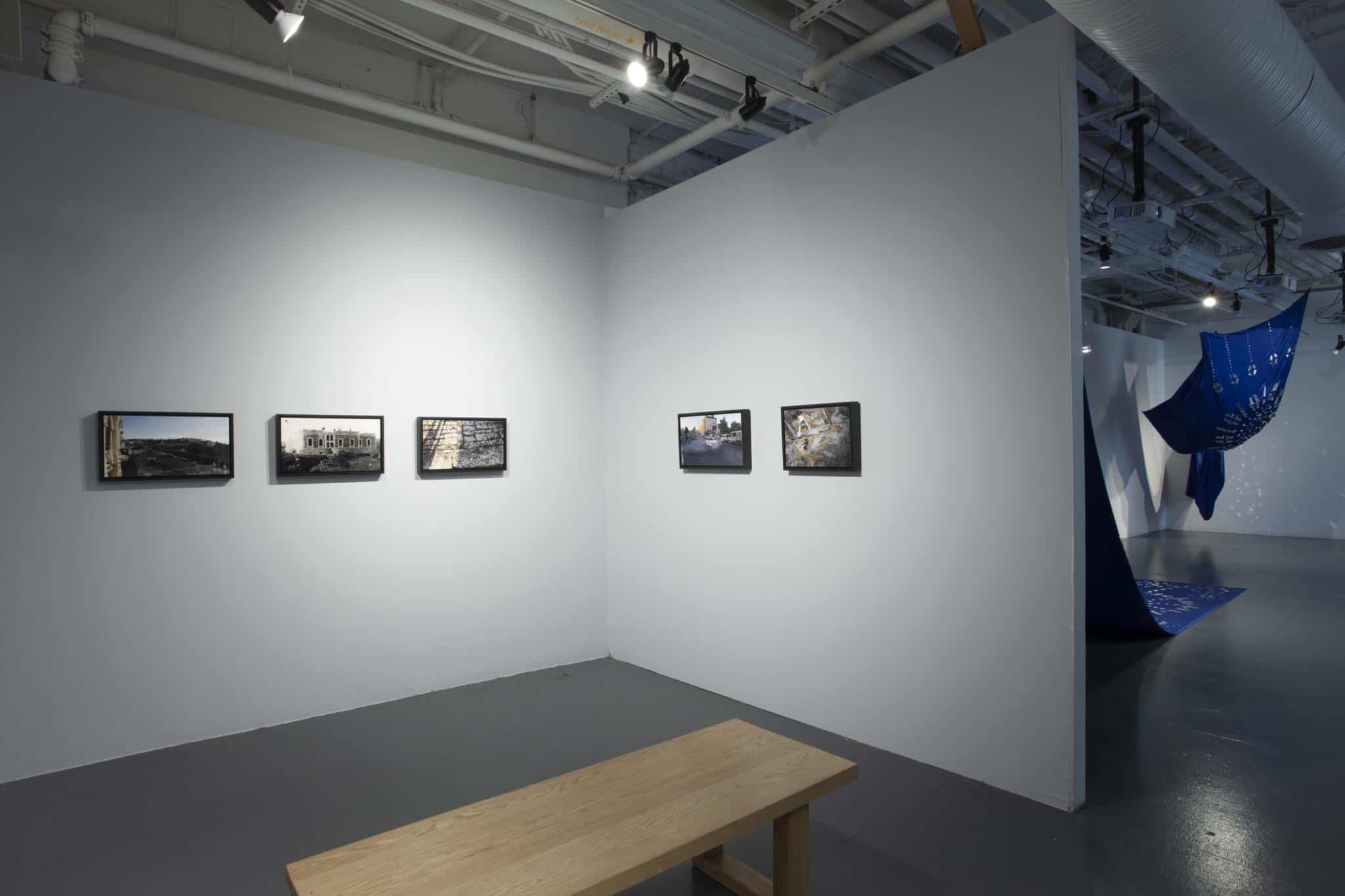
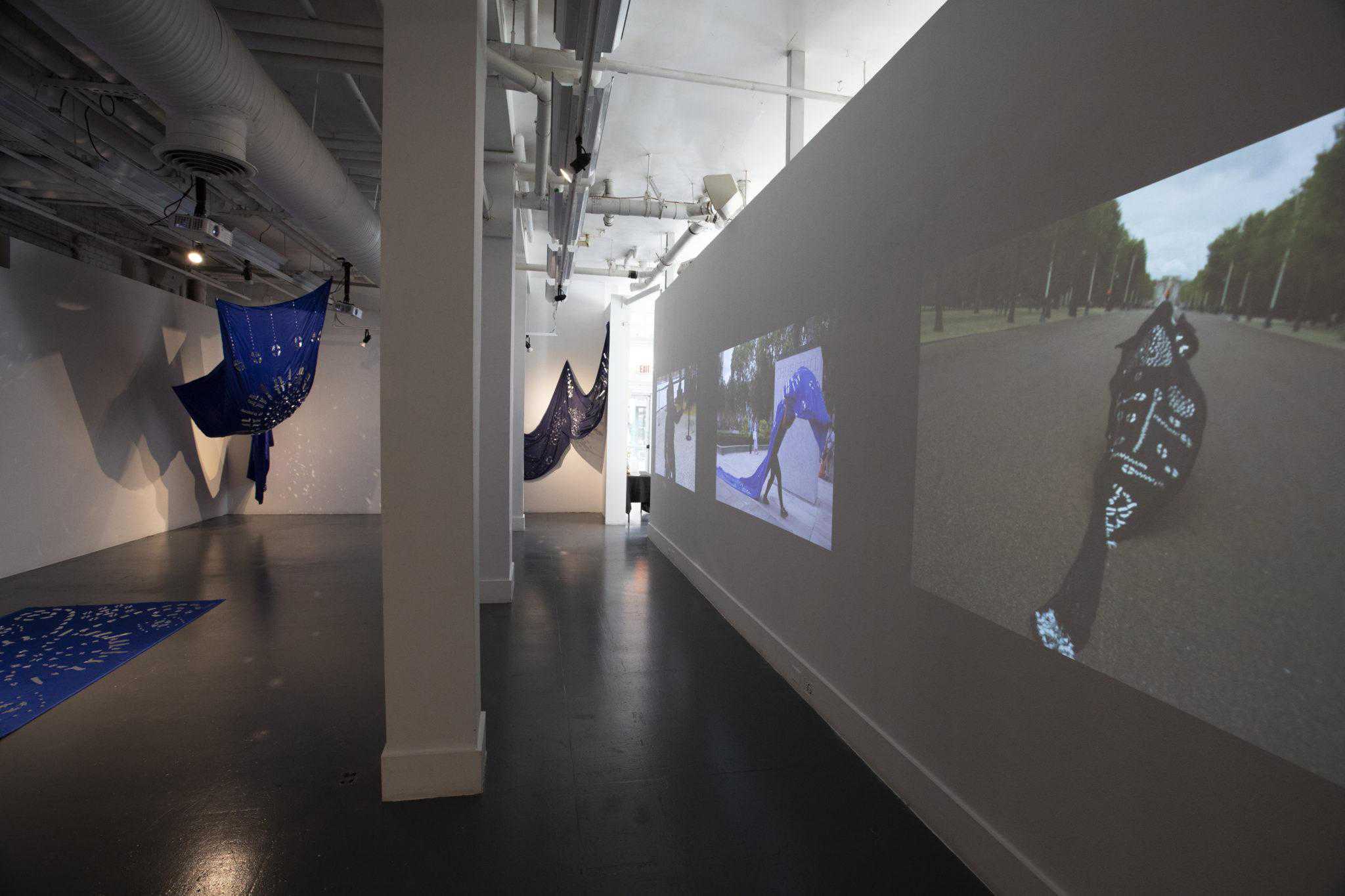
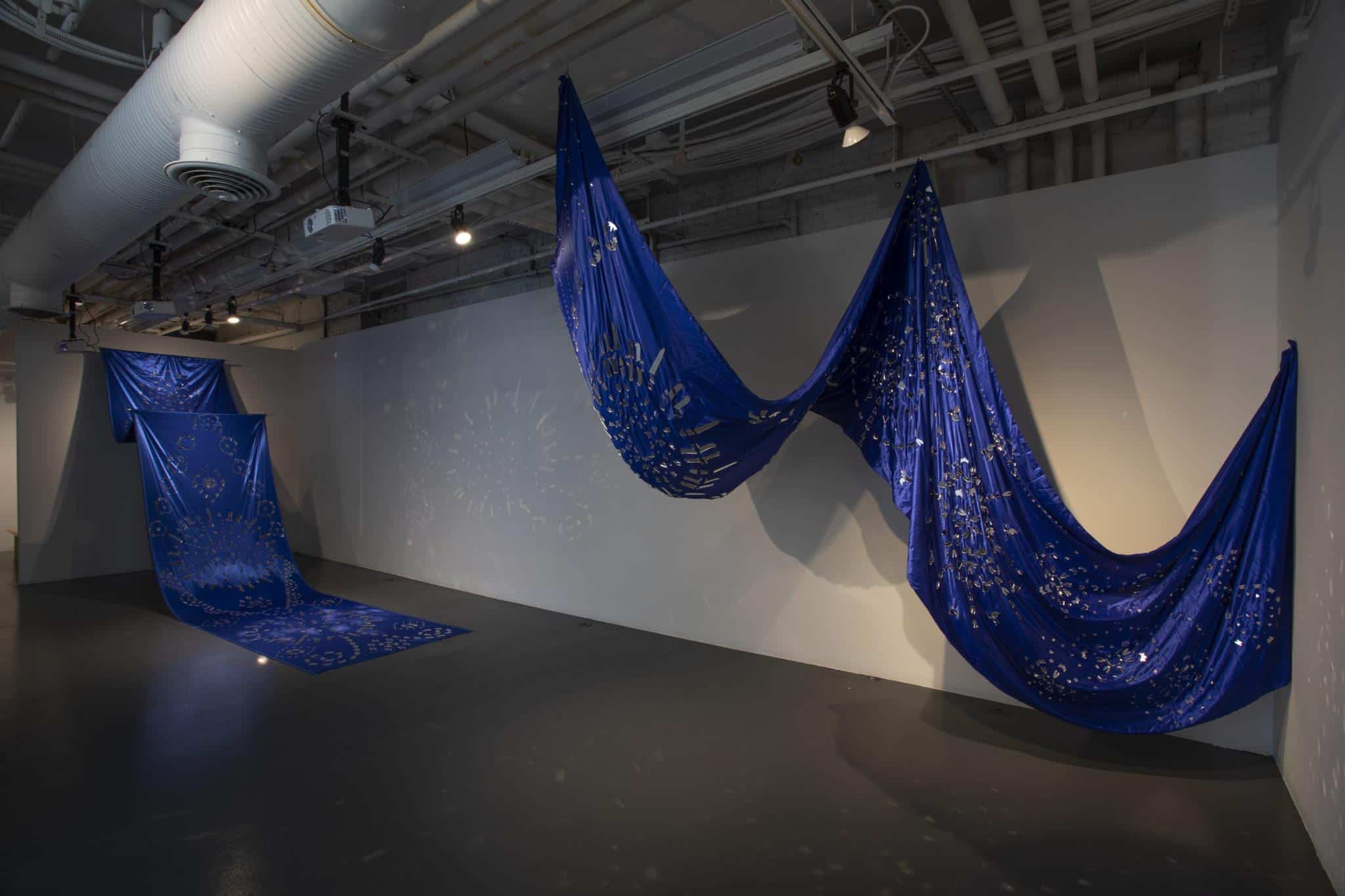
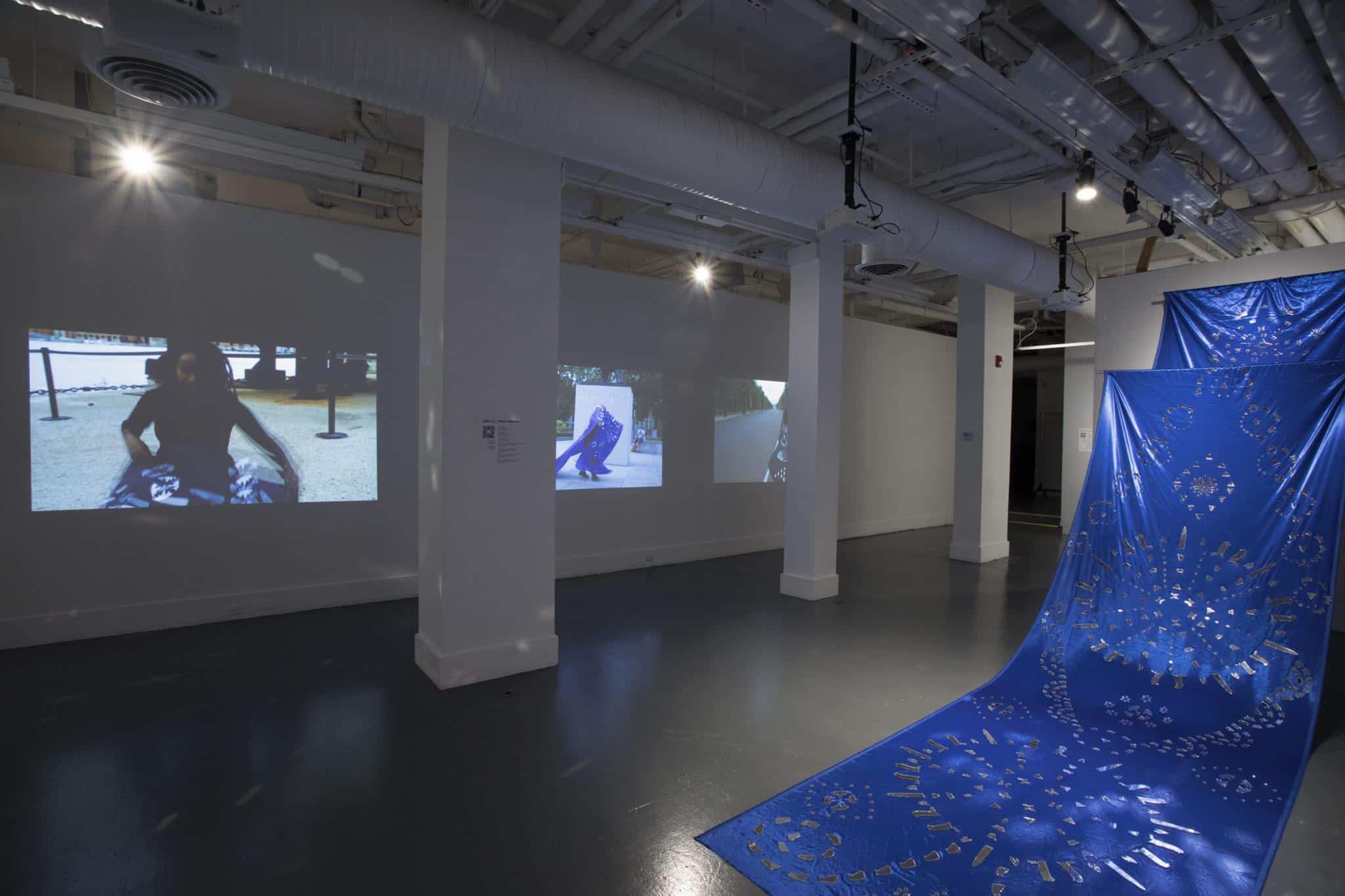
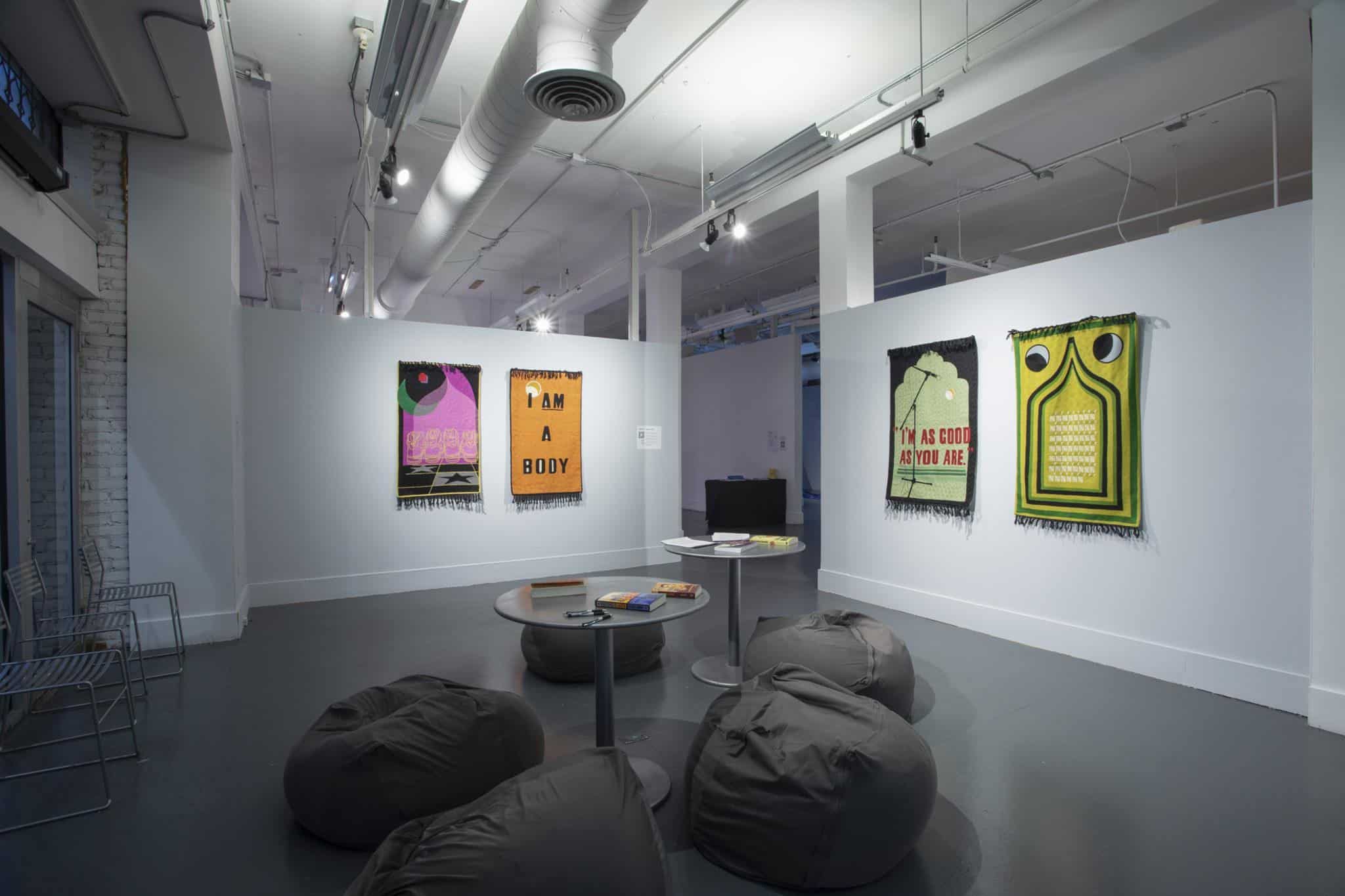

Introduction

Dyschronics is an exhibition that does not recognize clocks, linear progression, or chrono-logies. It is an antagonism to the “Western Hour” via interruptions, waiting, transitions, intervals, and in-between moments. It is a reconsideration of how moving bodies interact in space and time, across geographies, cultures, and identities, particularly those historically erased within migration data—namely womxn and non-binary people. Acknowledging that the modern construction of time, composed of chronos and kairos, or quantitative and qualitative time, is an imposition, Dyschronics revels in temporalities that resist this linear, monolithic tempo. Instead, it turns to times that historian Ranajit Guha characterized as confrontational, cultural theorist Mieke Bal later theorized as “heterochrony” or the clashing of times, and Miguel Á. Hernández-Navarro understands as dyschronys, or a “fourth time,” beyond and resistant to the so-called “Western Hour.”
Dyschronics features the work of Carolina Caycedo, Emily Jacir, Baseera Khan, Tsedaye Makonnen, and Dawit L. Petros in reconfigurations of space-time through installation, sculptures, textiles, videos, film, and performances throughout the galleries of Artspace, New Haven, and includes new commissions by Khan and Makonnen.
Dyschronics is accompanied by a public, free, and syncopated programming series, including artist lectures, screenings, performances, and tours. For more information about the series, please sign up for our newsletter.
Dyschronics is supported by the Andy Warhol Foundation, CT Humanities, Mellon Foundation, and VIA Art Fund. The exhibition is organized by guest curator, Laurel V. McLaughlin, in collaboration with Artspace New Haven.

Desincrónica es una exposición que no reconoce relojes, progresión lineal, o crono-logías. Es un antagonismo de la “hora occidental” a través de interrupciones, esperas, transiciones, intervalos, y momentos intermedios. Es una reconsideración de cómo los cuerpos en movimiento interactúan en el espacio y el tiempo, a través de geografías, culturas, e identidades, particularmente aquellos históricamente borrados dentro de los datos de migración—es decir, mujeres y personas no binarias. Reconociendo que la construcción moderna del tiempo, compuesta de cronos y kairos, o tiempo cuantitativo y cualitativo, es una imposición, Desincrónica se deleita con temporalidades que resisten este tiempo lineal y monolítico. En cambio, recurre a tiempos que el historiador Ranajit Guha caracterizó como confrontativos, que el teórico cultural Mieke Bal luego teorizó como “heterocronía,” o el choque de tiempos, y que Miguel Á. Hernández-Navarro entiende como desincronizaciones, o un “cuarto tiempo”, más allá y resistente a la llamada “hora occidental”. Desincrónica presenta la obra de Carolina Caycedo, Emily Jacir, Baseera Khan, Tsedaye Makonnen, y Dawit L. Petros en reconfiguraciones del espacio-tiempo a través de instalaciones, esculturas, textiles, videos, cine, y performances en las galerías de Artspace New Haven, e incluye una nueva comisión por Khan y Makonnen.
Desincrónica va acompañada de una programación pública, gratuita, y sincopada. Junto a conferencias de artistas, proyecciones, performances, y giras, como parte de la programación se presentan obras y programas que se manifiestan después de la inauguración oficial. Para obtener más información, visite el calendario de Artspace.
Desincrónica cuenta con el apoyo de la Fundación Andy Warhol, CT Humanities, la Fundación Mellon, y el Fondo de arte VIA. La exposición está organizada por la Laurel V. McLaughlin, comisaria invitada, en colaboración con Artspace.
Tsedaye Makonnen
Tsedaye Makonnen

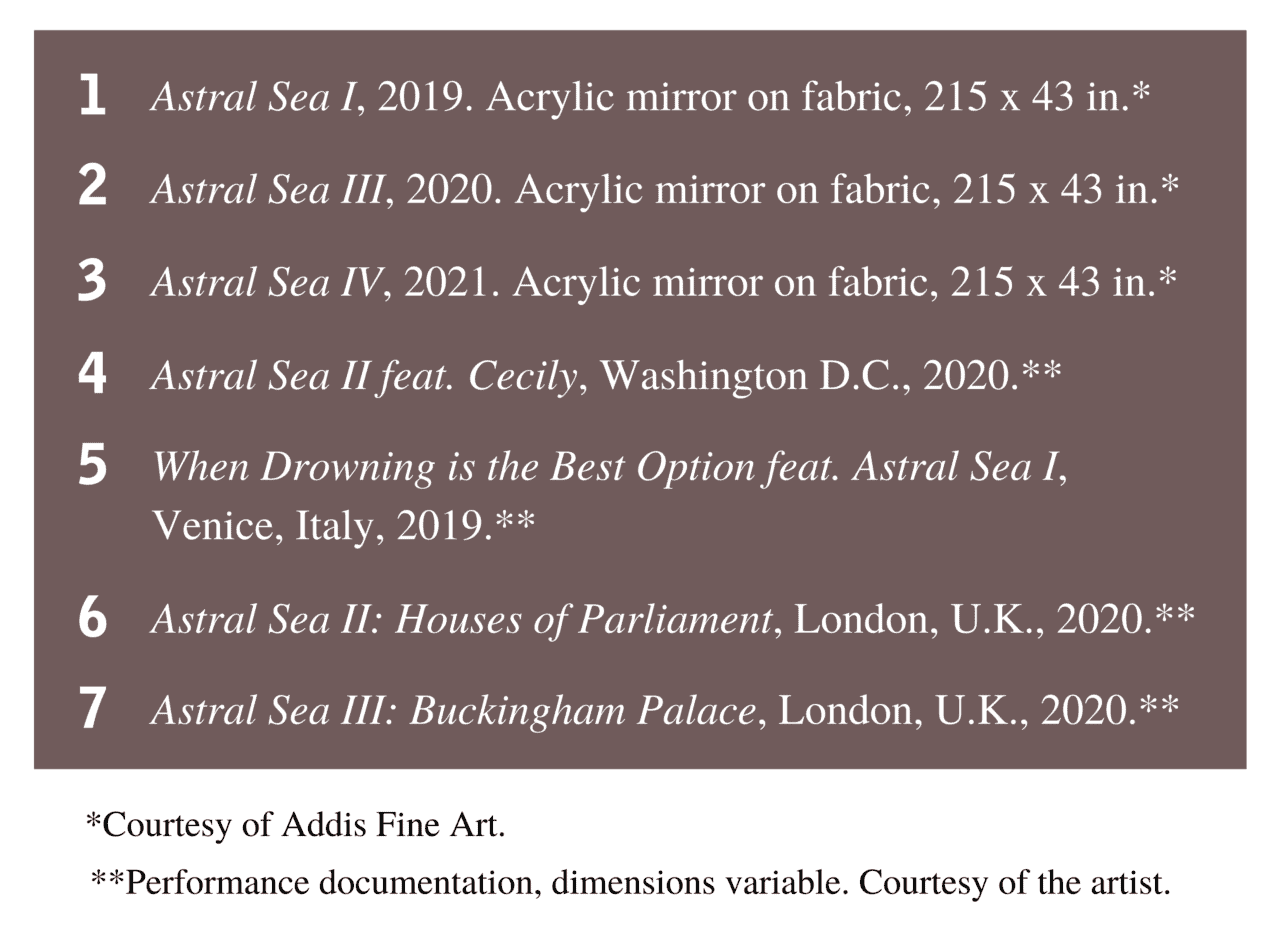
Tsedaye Makonnen’s “Astral Sea” series features four textile works and accompanying performances that meditate upon transhistorical forced migration of Black communities across the world. Illuminating the fabric are laser-cut mirrored surfaces excised from the negative spaces of Makonnen’s light sculpture towers, which reference 4th-century Ethiopian stelae (a type of obelisk) that marked graves with elaborate multi-register stories. Makonnen’s stories in her light towers turn away from the lineage of grand historical narratives to focus on the often-erased accounts of Black women and girls who have died from state-sanctioned violence in the U.S., or while migrating from East Africa to Europe across the Mediterranean Sea, or while on the Middle Passage from Africa to the U.S. (with the exception of the matriarchal foundations of each light tower, which are named after Black women elders who have passed away). Makonnen reorients the historical stories told in circular narratives around the vertically-structured stelae and disperses them across the textiles, in African symbols of ancient, present, and future time “encoded with protection, healing, [and] other messages,” as the artist says. Makonnen and her collaborators have activated the textiles through performances in various spaces and times ranging from the 2019 Venice Biennale to the Park Avenue’s 2020 project Armory 100 Years|100 Women, and the 2020 Black Lives Matter protests in Washington, D.C. at the Mall. These activations pay homage to the long durée of forced migration, while simultaneously honoring the free movements of all Black women.
Artspace New Haven has commissioned Tsedaye Makonnen with collaborators Jasmine Hearn, and Dominique Duroseau to realize a performance activation in the “Astral Sea” series at Long Wharf Pier. For more information, visit the Artspace New Haven calendar.

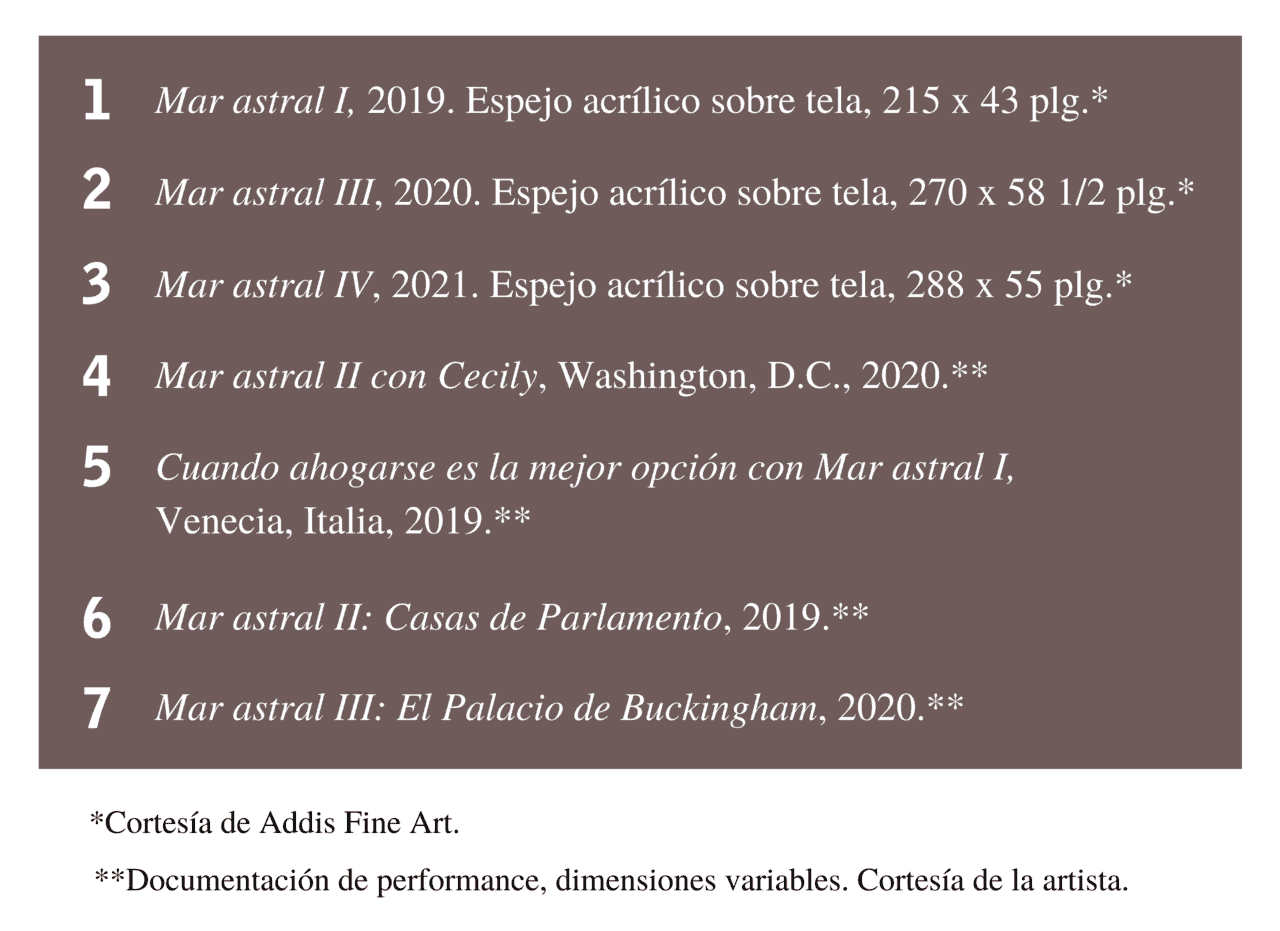
La serie “Mar astral” de Tsedaye Makonnen presenta obras textiles y performances acompañantes que meditan sobre la migración forzada transhistórica de las comunidades negras en todo el mundo. Iluminando la tela hay superficies espejadas cortadas con láser, que se extraen de los espacios negativos de las torres de las esculturas de luz de Makonnen. Estas formas hacen referencia a un tipo de obelisco etíope del siglo IV denominado stelae. Las stelae se usaban para marcar tumbas con elaboradas historias de múltiples registros. Las historias que Makonnen incluye en sus torres de luz se alejan del linaje de las grandes narrativas históricas para centrarse en los relatos a menudo borrados de mujeres y niñas negras que han muerto a causa de la violencia sancionada por el estado en los EE. UU., o durante su migración desde África Oriental a Europa a través del Mediterráneo, o durante la migración forzada desde África a los EE. UU. durante el denominado “middle passage” (hay una excepción: los cimientos matriarcales de cada torre de luz llevan el nombre de ancianas negras que murieron). Makonnen reorienta las narrativas históricas al contarlas de manera circular alrededor de las estructuras verticales de las stelae y las dispersa a través de los textiles usando símbolos africanos del tiempo antiguo, presente, y futuro “codificados con protección, curación, [y] otros mensajes,” como dice la artista. Makonnen y sus colaboradores han activado los textiles a través de performances en varios espacios y tiempos que van desde la Bienal de Venecia de 2019 al proyecto Armería 100 años|100 mujeres de Park Avenue, y las protestas de Black Lives Matter en la explanada de Washington, D.C en 2020. Estas activaciones rinden homenaje a la larga duración de la migración forzada, al mismo tiempo que honran los movimientos libres de todas las mujeres negras.
Artspace New Haven ha comisionado a Tsedaye Makonnen con colaboradoras Jasmine Hearn y Dominique Duroseau a que realicen una activación de la performance de la serie “Mar astral” en Long Wharf Pier. Para obtener más información, visite el calendario de Artspace New Haven.
Baseera Khan
Baseera Khan


The installation Reading Room, on purpose in Gallery 2 introduces publics to Baseera Khan’s research and notes that inform their work. Khan’s artistic practice specifically confronts capitalism and its control over bodies, religions, and cultures, instead, creating space for “exile and kinship,” as they say. The artist welcomes publics to sit, read, and annotate the materials gathered here, which record multiple trajectories and conceptualizations that collectively resist a singular or linear understanding of selfhood and artistic production. Along the walls, works from Khan’s “Psychedelic Prayer Rugs” series, made in collaboration with rug makers in Kashmir, evoke a spiritual, psychedelic atmosphere derived from Khan’s personal experience as a POCQ (person of color and queer) femme Muslim woman in the U.S. Oriented towards prayer and inward reflection, the rugs bear inscriptions that separate them from patriarchal and restrictive forms of being.
Khan’s works in Gallery 3, Seat 25 Purple and Black and House I, invite contemplation concerning the time of rest through dream and portal-like shapes, while the new commission, Love Ceremony, offers publics the chance to seat themselves in embodied positions of repose.


La instalación Sala de lectura, a propósito en la Galería 2 presenta al público la investigación y las notas que componen el trabajo de Baseera Khan. La práctica artística de Khan se enfrenta específicamente al capitalismo y su control sobre cuerpos, religiones, y culturas, creando en cambio un espacio para el “exilio y el parentesco,” como dice Khan. Los materiales aquí reunidos registran múltiples trayectorias y conceptualizaciones que resisten una comprensión singular o lineal de la individualidad y la producción artística. A lo largo de las paredes, las obras de la serie “Alfombras de oración psicodélicas” de Khan, realizadas en colaboración con fabricantes de alfombras en Cachemira, evocan una atmósfera espiritual y psicodélica derivada de la experiencia personal de Khan como mujer musulmana POCQ (persona de color y queer) en los EE. UU. Orientadas hacia la oración y la reflexión interior, las alfombras llevan inscripciones que las separan de formas de ser patriarcales y restrictivas.
Las obras de Khan en la Galería 3, Asiento 25 Morado y negro y Casa I, invitan a la contemplación del tiempo de descanso a través de formas oníricas y de portales, mientras que su nuevo encargo, Ceremonia de amor, ofrece al público la posibilidad de sentarse en posiciones de reposo encarnadas.
Carolina Caycedo
Carolina Caycedo

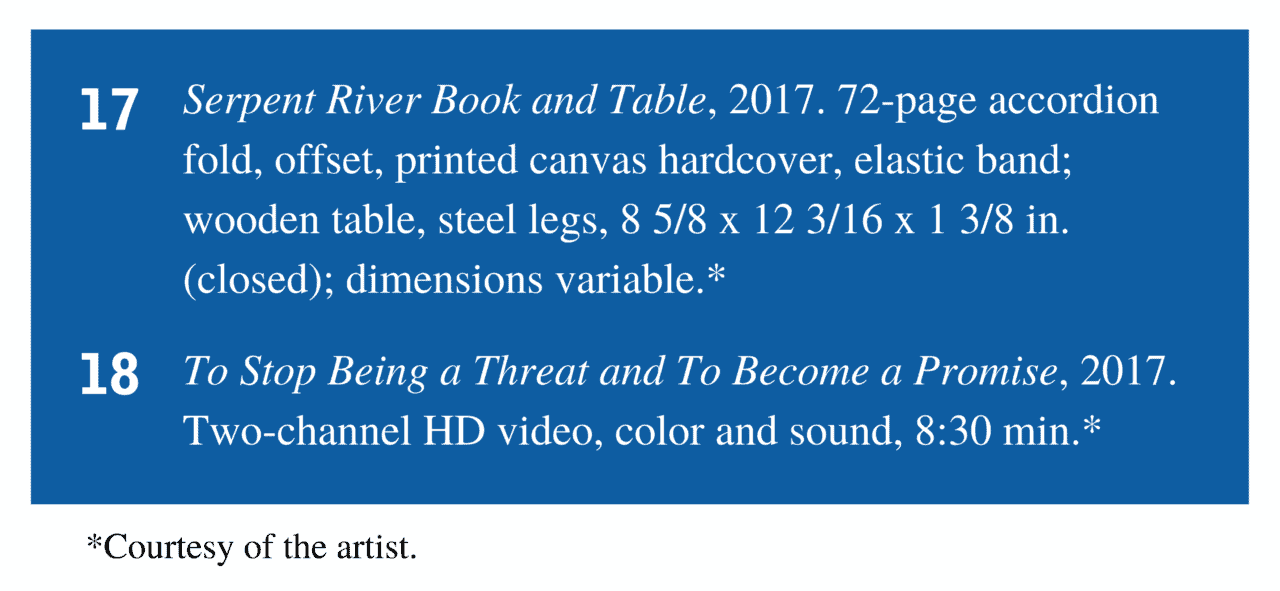
Carolina Caycedo’s installation Serpent River Book and Table and video To Stop Being a Threat and To Become a Promise, both come from her larger “Be Dammed” series, which investigates the compounded and devastating results of capitalist extractivism on natural and social landscapes throughout the territories currently known as the Americas.
Stretched across Gallery 3, Caycedo’s installation Serpent River Book displays fragments of archival images, maps, poems, lyrics, satellite photos, the artist’s images and texts on river bio-cultural diversity. These visual materials reference Caycedo’s work with Colombian, Brazilian, and Mexican communities as they encounter the displacing effects of industrialization and privatization over their river systems. The serpentine book extends and folds natural time, stretching and cutting short numerous narratives, retaining possibilities for reading in countless directions and cycles. In this way, publics might view it as performative, much like a present or futural score, or as a workshop tool considering the past.
Alongside the text, Caycedo’s two-channel video To Stop Being a Threat and To Become a Promise illuminates the expansive and cyclical hydrographies such as the Colorado, the Yaqui, the Xingu, the Spree, and the Magdalena Rivers, juxtaposing Indigenous knowledge against extractivist uses of water and land. Gradually, throughout the course of the video, the Indigenous perspective “casts visual spells on the extractive one, making it wobble, shake, unfold, and eventually transforming it into a spiritual vision,” as the artist says. In this digital glitching, publics see a clashing of temporalities in relation to water ecologies between the static and linear, and the proliferating and unfolding.

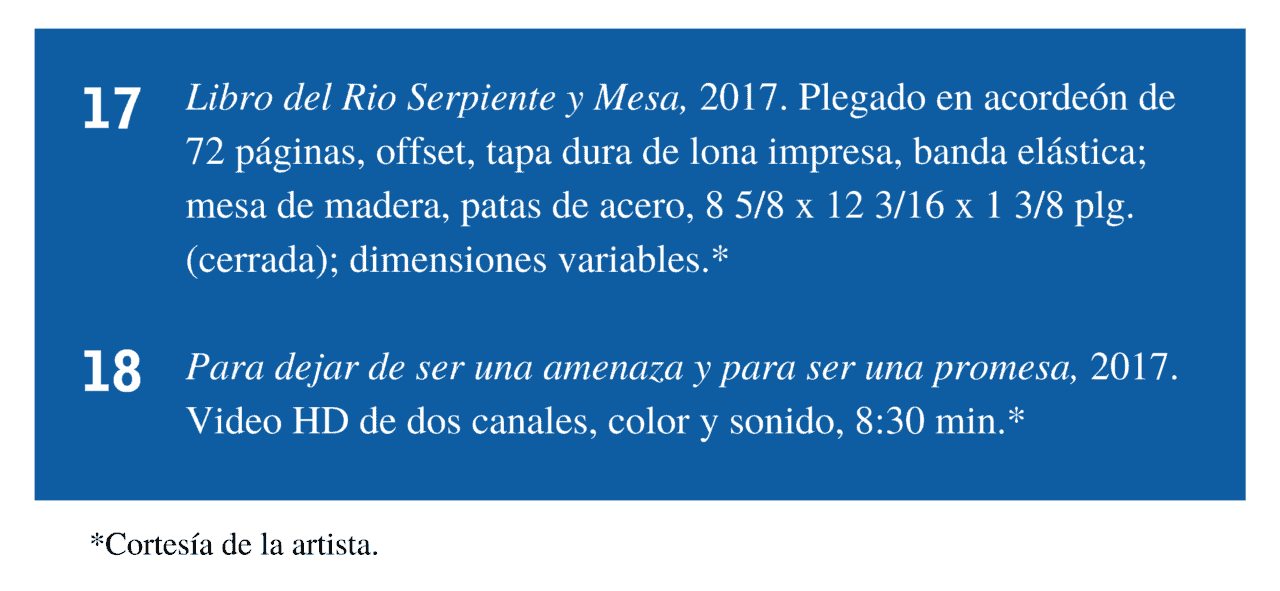
La instalación de Carolina Caycedo Libro del Rio Serpiente y Mesa y el video Para dejar de ser una amenaza y para ser una promesa, ambos provienen de su serie más grande “Maldito seas,” que investiga los resultados combinados y devastadores del extractivismo capitalista en paisajes naturales y sociales en todos los territorios actualmente conocidos como las Américas.
Extendida a lo largo de la Galería 4, la instalación de Caycedo Libro del Rio Serpiente muestra fragmentos de imágenes de archivo, mapas, poemas, letras, fotos de satélite, imágenes de la artista, y textos sobre la diversidad biocultural de los ríos. Estos materiales visuales hacen referencia a la labor de Caycedo con comunidades colombianas, brasileñas, y mexicanas que enfrentan los efectos del desplazamiento sobre sus sistemas fluviales a causa de la industrialización y privatización. El libro serpenteante extiende y dobla el tiempo natural, estirando y cortando numerosas narrativas y conservando las posibilidades de lectura en innumerables direcciones y ciclos. De esta manera, el público podría verlo como una performance, como una partitura actual o futura, o como una herramienta de taller que considera el pasado.
Junto al texto, el video de dos canales de Caycedo Para dejar de ser una amenaza y para ser una promesa ilumina las hidrografías expansivas y cíclicas como los ríos Colorado, Yaqui, Xingu, Spree, y Magdalena, yuxtaponiendo conocimiento indígena contra los usos extractivistas del agua y la tierra. Poco a poco, a lo largo del video, la perspectiva indígena “lanza hechizos visuales sobre la extractiva, haciéndola tambalear, sacudir, desplegar, y eventualmente la transforma en una visión espiritual”, como dice la artista. En esta falla digital, el público ve un choque de temporalidades en relación con las ecologías del agua entre lo estático y lineal, y lo que prolifera y se despliega.
Emily Jacir
Emily Jacir


Emily Jacir’s documentary letter to a friend chronicles an epistolary and diaristic account in which the artist asks a close friend, Eyal Weizmann, the Founding Director of the multidisciplinary research group Forensic Architecture, to start an investigation of a crime before the inevitable act occurs. In Bethlehem, the artist’s familial home, Dar Jacir, stands at the crossroads between a displaced persons camp and occupied Palestinian territory. Throughout the film’s intertwinement of images, movements, memories, archival traces, and recorded sounds compiled from research throughout a century, the 1880s-built multigenerational house and the experiences it contains bear decades-long and ongoing witness to conflicted, joyous, and seemingly static times. The orientation of the film in an anticipatory temporality, however, challenges publics to imagine an eventual destruction, which occurred on May 15, 2021 when a fire decimated its garden and urban farm and Israeli soldiers raided the current premises, the Dar Yusuf Nasri Jacir for Art & Research.
Jacir’s photographs are familiar images from the video and documentation in her research-based narrative. Their stilled depictions convey past and current temporal states, all in the service of the future of Dar Jacir, its sitedness in Bethlehem in the midst of conflict and internal displacement, and the prognosis of the artist in the documentary.

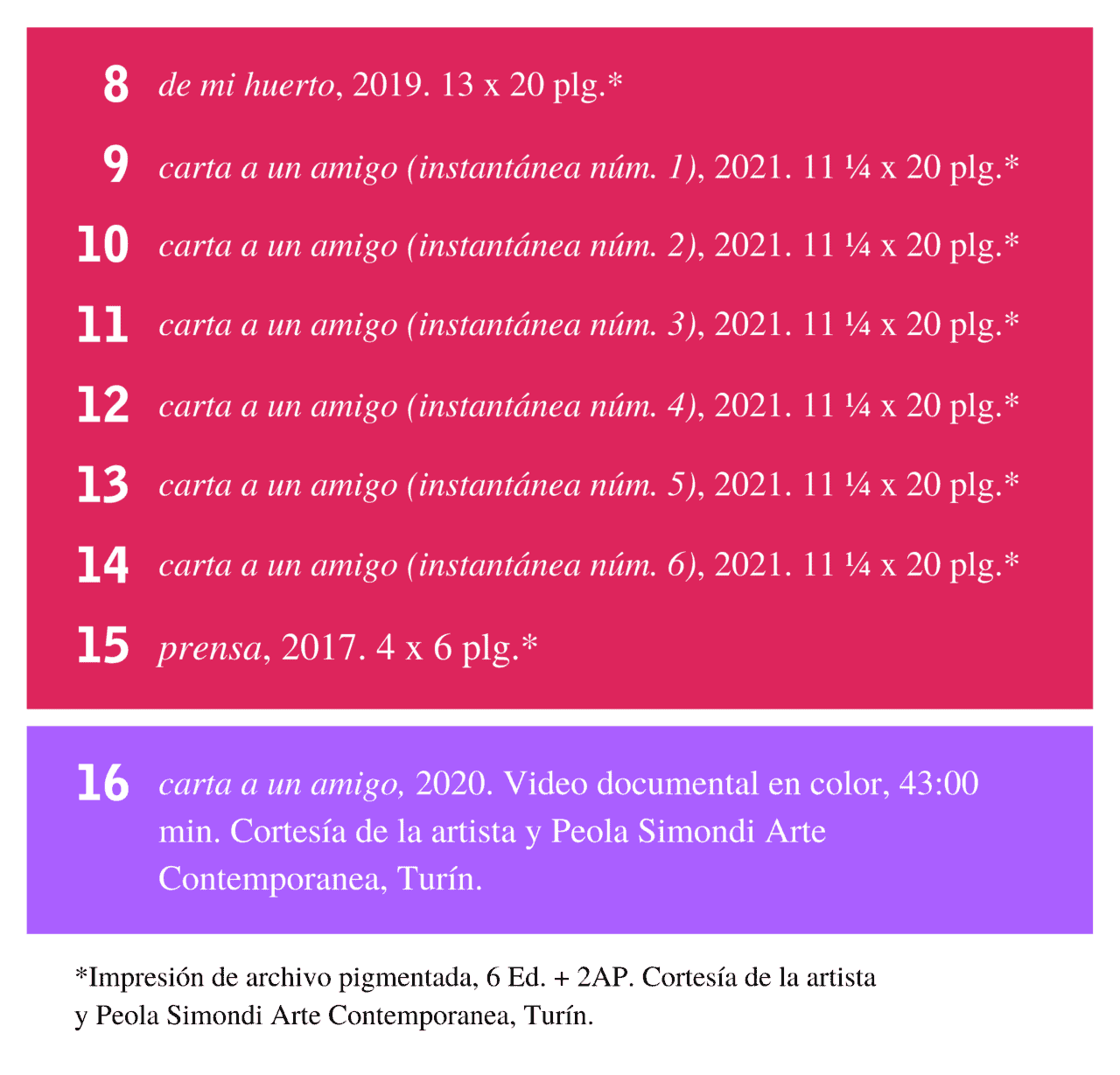
El documental de Emily Jacir carta a un amigo narra un relato epistolar y en formato de diario en el que la artista le pide a un amigo cercano, Eyal Weizmann, director fundador del grupo de investigación multidisciplinar Forensic Architecture, que inicie una investigación de un crimen antes de que ocurra el acto inevitable. En Belén, la casa familiar de la artista, Dar Jacir, se encuentra en la encrucijada entre un campo de personas desplazadas y el territorio palestino ocupado. El documental entrelaza imágenes, movimientos, recuerdos, huellas de archivo, y sonidos, compilados como parte de una investigación a lo largo de un siglo. La casa multigeneracional de la familia de Jacir, construida en los 1880, y las experiencias que contiene son testimonios a través de décadas pero a la vez continuos del tiempo de conflicto y alegría aparentemente estáticos. La orientación de la película en una temporalidad anticipatoria, sin embargo, desafía al público a imaginar una eventual destrucción, que ocurrió el 15 de mayo de 2021 cuando un incendio diezmó su huerto y granja urbana, y los soldados israelíes asaltaron el local actual, el Dar Yusuf Nasri Jacir de Arte e investigación.
Las fotografías de Jacir son imágenes familiares del video y la documentación de su narrativa basada en la investigación. Sus estáticas representaciones transmiten estados temporales pasados y presentes, todo al servicio del futuro de Dar Jacir, su espacio en Belén en medio del conflicto y el desplazamiento interno, y el pronóstico de la artista en el documental.
Dawit L. Petros
Dawit L. Petros
The exhibition Dyschronics continues at the 96 Orange St. storefront windows and is accessible to the public 24/7 through April 22nd.
Dawit L. Petros and collaborators, Inscribed Surfaces: On Transient Histories, 2022. Edition of 15 drawings on fabric with henna, 28 x 60 in. Courtesy of the artist and collaborators.
For Inscribed Surfaces: On Transient Histories artist Dawit L. Petros collaborates with architectural designer Alberto Ortega Trejo, artist Jess Atieno Ounga, researcher Simon Ghebreyesus, studio technician Noah Taylor, workshop assistant Iman Iftikhar, and workshop participants, Ragaa Abdella, Yasmin Bergemann, Tay Holloway, Yamil Rivas, Selihom Yoseif, Laiga Walli, to realize a newly-commissioned edition of henna drawings. Exhibited in a storefront space at 96 Orange St. and open 24/7 to the public, the edition was conceived during a closed workshop over coffee, conversation, and henna-making on March 26th, 2022. In the workshop, Petros evokes childhood experiences of sharing coffee and henna recipes with his mother and women in his Eritrean community. In this space of rest and communal connection, workshop collaborators and Petros created multilayered ephemeral drawings on textile through the ancient material and embodied tradition of henna, which reference modernist architectures from New Haven, migrations across the Horn of Africa, and the potential of new relations with and through time and history.
La exposición Dyschronics continúa en las ventanas de la tienda de 96 Orange St. y está accesible al público las 24 horas del día, los 7 días de la semana hasta el 22 de abril.
Dawit L. Petros y colaboradores, Superficies inscritas: Sobre historias transitorias, 2022. Edición de 15 dibujos sobre tela con henna, 28 x 60 pulg. Cortesía del artista y colaboradores.
Para Superficies inscritas: Sobre historias transitorias, el artista Dawit L. Petros colabora con el diseñador arquitectónico Alberto Ortega Trejo, la artista Jess Atieno Ounga, el investigador Simon Ghebreyesus, el técnico de estudio Noah Taylor, y participantes del Ragaa Abdella, Yasmin Bergemann, Tay Holloway, Yamil Rivas, Selihom Yoseif, Laiga Walli, para realizar una edición recién encargada de dibujos con henna. Exhibida en un espacio de una tienda en la Calle Orange 96 y abierta al público las 24 horas del día, los 7 días de la semana, la edición fue concebida durante un taller cerrado con café, conversación, y elaboración de henna el 26 de marzo de 2022. En el taller, Petros evoca experiencias de la niñez cuando compartía recetas de café y henna con su madre y mujeres en su comunidad de Eritrea. En este espacio de descanso y conexión comunitaria, los colaboradores del taller y Petros crearon dibujos efímeros en textil de varias capas a través del antiguo material y la tradición encarnada de la henna, que hacen referencia a las arquitecturas modernistas de New Haven, las migraciones a través del Cuerno de África, y el potencial de nuevas relaciones con y a través del tiempo y la historia.